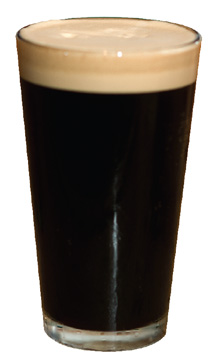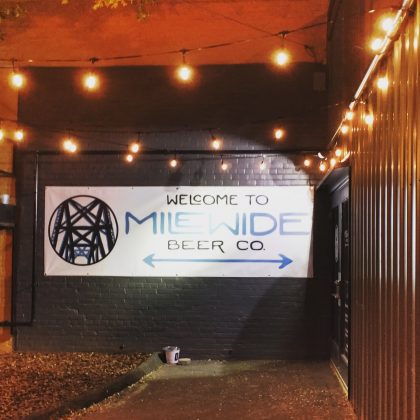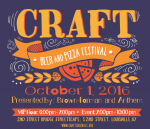A brief note from the “editor” – Roger’s column will continue to be a bi-monthly feature scheduled for publication on the 1st and 15th of each month. August was an exception: mid-month Roger was assigned the grueling task of shooting video footage of the Great Taste of the Midwest in Madison, WI. He survived the ordeal with life and liver intact and brought us this:
In the next few days we will be releasing an exciting new addition to the website titled Pint Counter Pint. Stay tuned, it’s gonna be good. – John Campbell
Fear of the Dark
by Roger Baylor
 Consider a brown dog, sleeping beneath a tree’s leafy summertime green, with deep blue skies and puffy white clouds overhead. A woman dressed in yellow workout gear jogs past scarlet flowers, illuminated by the fiery orange sun.
Consider a brown dog, sleeping beneath a tree’s leafy summertime green, with deep blue skies and puffy white clouds overhead. A woman dressed in yellow workout gear jogs past scarlet flowers, illuminated by the fiery orange sun.
In visual terms, most of us would regard this tranquil scene as aesthetically pleasing. Likely it would be more enriching if we could smell freshly cut grass, hear a busker strumming, and feel the cool, gentle breeze on our faces. There is undisputed glory in a multiplicity of senses, and it is a tragedy when one or more is taken away by illness or circumstance.
Meanwhile, three men sit at an Irish pub, deep in conversation, each drinking a pint of draft beer. The liquid in one glass is golden, the next amber/red, and the last black. Each man smiles broadly as he drinks. It is a scene of diversity and encouragement, and yet more than a few beer drinkers will rely on their vision alone and lock the brakes: “Oh … but I don’t like dark beer.”
Every day, human beings make snap judgments on a variety of stimuli based on the information supplied them by their basic sensory receptors. Beer is no exception, and experience has taught me a predictable cadence to the thought process of randomly chosen consumers.
The more experienced and beer-worldly types tend to ask questions or lament that they lack the time to drink one of each. However, beer novices seem always to want to know the color of the beer, and with this information tucked away in cranial filing drawers of pre-conceived notions, they’re prepared to choose by asking: “Do you have anything, umm, lighter?”
It amazes me that “dark” beer continues to frighten considerable segments of the populace, who if given a choice, generally will opt for the relative familiarity and presumed safety of golden colored beer.
And yet, in these halcyon days of genuine beer choice, it may well be the case that the pale, straw-colored beer is an Imperial Pilsner, far stronger in alcohol, intensely hoppy and bitter, while the espresso-hued beverage sitting next to it, perhaps Dry Stout or English Mild, is light-bodied, quaffable and much less filling.
For those who are creatures of beer habit and not open to what’s new and different, little of this will matter, and that’s fine, insofar as without a “blind” conformity to the blandness of the mass market, AB-Inbev’s stockholders in Andorra and Brazil wouldn’t be able to afford Thai sex holidays for themselves and chalets in the Canadian Rockies for their grandchildren.
(LEO Weekly would have omitted the previous paragraph owing to genetic timidity in the face of corporatism. Aren’t you excited that Louisville Beer Dot Com is here to give us Free Beer Speech?)
However, if the notion of “viva la difference” intrigues you, beer’s appearance is only one hint of many, and the best way to move forward in educating your palate is to begin learning about style basic.
Because rules governing beer style are fluid and constantly evolving, and seeing as they pertain as much to artistic interpretation as historical precedent, styles are by necessity generalized and subject to revision.
Know the difference between the two primary groupings in the beer canon, ale and lager. The historically warmer fermentation temperatures of ale yield a wider variety of aromas and flavors, while lager – the outgrowth of a more modern, scientific approach to brewing – aims for a clean profile without the distinctive flavors and aromas of ale. Stylistic branches grow in all directions from these two primary groupings.
Most importantly of all, remember that life is too short to drink in fear. Countless times it has been said to me, “I don’t like beer,” to which I reply: “What beers have you had?” If the answer comes back, “All of them – Bud, Miller, Coors, Corona and Heineken,” then I’m usually mere seconds away from claiming a convert by suggesting he or she try the available beer most unlike the golden lagers that have failed to inspire.
Even if one prefers the mainstream, it remains that you’ll never know until you try. The search for the perfect beer begins today, and it should continue for a lifetime. Let’s use all the senses, shall we?





